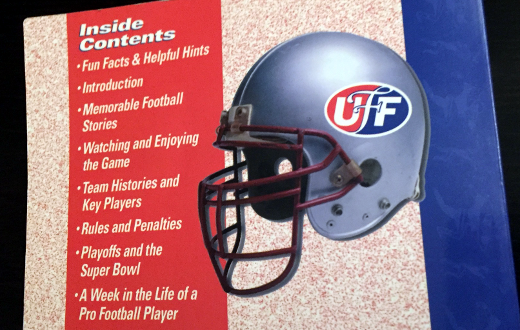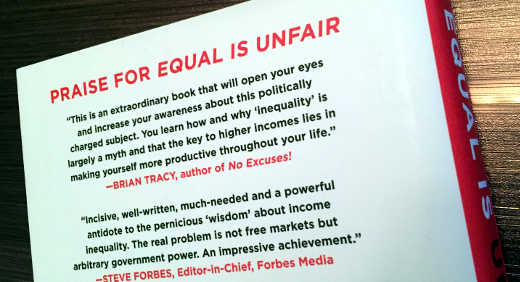My Takeaways From The Ultimate Female Fan Guide to Pro Football
The Super Bowl is a game you prepare for mentally, physically or both – depending on your level of fandom, and what you are watching it for. It is unique among sports as even non-fans watch, for the commercials, because they are at parties, for curiosity sake, et. al.
If you are a football fan, you realize the complexity of the rules of the game – realize in that you understand them all, none of them, or as many are, somewhere in between. How much you may know is most likely influenced by if you played football, was taught by a parent or someone else close to you or you learned on your own… he latter being the case for myself. Football for me wasn’t my first love of sports, but has become it. I grew up a baseball fan, which came from my Mom’s love of the Boston Red Sox. While I was growing up, the New England Patriots were horrible, and the bottom rung of the sports ladder in New England, way behind the Sox, Boston Celtics and Boston Bruins.
So when I decided on a whim to get season tickets for the Patriots back in the early 90’s, before they became the multiple Super Bowl winning team they are now, where I had some knowledge of the game, I had much to learn. As I was in my mid-20’s at that time, I was a little embarrassed that I didn’t know more of the game, and sought out a way to learn it. I found a book that not only helped me then, but over 20 years later as well.
I found the book The Ultimate Female Fan Guide to Pro Football at the Patriots Pro Shop, which was adjacent to the team’s former home field, Foxboro Stadium. Flipping through it, I realized it was exactly what I needed to learn the game. Two decades later I found it among some things, and I dusted it off and re-read it. My takeaways, as follow, come from my recollection of my initial read as well as this recent unearthing of it.
Structured Learning Is Sometimes Better Than On-The-Task Learning – As most of my training and learning over my career has been on-the-job or just-in-time and supplemented by some training, depending on the topic structured learning is the better way, as it was for me with football. Simply sitting down and watching 60 minutes of plays over 3 hours may not even cover everything, and taking a methodical approach supplemented with watching the game helped me learn it well.
Anecdotal Information Provides Greater Context To Formal Knowledge – Learning the formal rules of football, like any other topic, is important to learning about what you are watching. But for a game like football which has evolved over close to 100 years, having familiarity of the evolution and events which led to where the game is today is great to the deep understanding of the game. Betsy Berns mixes helpful hints and fun facts throughout the pages of The Ultimate Female Fan Guide to Pro Football, all of which provide greater context to the main information presented.
What Taught Me Helps Teach Others - When I found the book, I wanted to go through it again as I am teaching my daughter the rules of football. As I am writing this I am sitting down with her and we are going through it together, and I am helping her understand both the rules for and my love for the game, which I hope will lead to her own appreciation and affection for it too.
As my copy of The Ultimate Female Fan Guide to Pro Football came out over 20 years ago, what I have is now out of print and is now known simply as The Female Fan Guide to Pro Football by the same author. Where I haven’t read the newer version specifically, I can only imagine it is better (not to mention more up to date) than my version. I recommend it to any fan of any reading age – and gender – as a great way to learn this great game.
This is from The Hot Iron, a journal on business and technology by Mike Maddaloni.
Did you enjoy this? Subscribe to The Hot Iron by RSS/XML feed or Read by Email.
Book Take-Aways • Strategize • Thrive • (0) Comments • Permalink
7 Lessons Learned From Blogging For 10 Years

On Saturday, December 30, 2006 at 1:56 pm Central US Time, I published my very first blog post here at The Hot Iron. If you didn’t click on the link to read it, it would have taken longer to read this sentence than to read that post. Now ten years and 822 posts later, I am entering my second decade of blogging.
Where every year on my “blogversary” I have written a post to acknowledge it (some more robust than others), rather than simply patting myself on the back again, I’d like to share some of the lessons I have learned over the years of writing.
1. You never know who is reading – Despite knowing the Internet is Earth-wide, I still get amazed as to the reach of what I have written. Whether it’s companies inviting me to dinner or to travel the world, to the one time when someone quoted to me something I wrote myself, the true exposure is something I need to remind myself before I click the publish button each time.
2. Answer a question with a blog post – As the genesis of this blog was out of my former Web consulting firm, I found it useful to use The Hot Iron as not only a means of promoting my business but to create “reusable” content. Whenever someone asked me a question that I believed someone else may ask me, I would create a blog post on it and send them the link in response to their query. It not only answered their question, but made me look smarter as I wrote something on it, and made answering the question the next time all the easier. I still do that to this day.
3. Blogging can help you be a better writer – Before I started blogging, most of my writing was emails and technical specifications and documentation. Over time, I not only honed my writing but found myself greatly enjoying it. Many people have told me that they find it hard to get into a groove on writing, and if you look at my first few posts to those I write today, you will see quite a progression. More on the writing process later.
4. Simply placing ads on your blog won’t make you rich – Some of you may be surprised by this statement, and others of you are surely smirking at it, as you learned this the hard way yourself. From banner ads, Amazon product links to payment services like the former CentUp or soon-to-be former Google Contribute, ads may bring in a little loose change, but it takes a concentrated effort and plan to make real income from your blog.
5. Allow people to subscribe by RSS or email – Many of my most faithful readers are ones who receive my blog posts in their inbox or in their RSS feed reader. Even though Google killed off its Reader product years ago, people still aggregate content by RSS feeds in their Web browser or other services such as Fever. Making it easy for people to read what you write will keep readers reading.
6. Control your blog platform – Over years I have seen people post loyally on a variety of public platforms, from Geocities to Posterous, only to see those services shut down and their content vanish, especially as they never had a backup of their own writing! I am in the business of helping people get their message out on the Web, and I sill profess the best way is to do so is to have control of your Web publishing platform. Your own domain name coupled with any one of the number of content management systems (CMS) out there will give you the ability to manage your message as well as move it if necessary.
7. Blog posts don’t write themselves – Doing the math, I have written and published about 1.5 posts a week. On the surface this looks good, but looking back on early posts – especially those before the social media boom which would have probably been tweets rather than blog posts – there was irregularity and long periods where posts were published and where they were not. It takes a commitment to writing – focusing on actually finishing writing, editing and publishing something. I also like to add original photos to posts, which will take me on a hunt to find the right shot (like the one above at a liquor store – there are worst places to go) and more time. But as I do enjoy writing, it’s also a hunt to find time when I am caffeinated and have thoughts pouring out of my head, as I am as I write this.
Deconstructing Ten Years of Blogging
There are very few things in our lives that we can measure in terms of decades, and I can now count this blog as one of them. For as much work that goes into writing what I share here at The Hot Iron, it is truly something I enjoy doing. This makes the time I have devoted to this labor of love all the more worth it. Feedback from readers rounds out the overall experience, and for that I am also grateful. Now on to post 823.
This is from The Hot Iron, a journal on business and technology by Mike Maddaloni.
Did you enjoy this? Subscribe to The Hot Iron by RSS/XML feed or Read by Email.
Announcements • Blogging • Thrive • (1) Comments • Permalink
7 Lessons Learned From Serving On A Non-Profit Board

As the year winds down, a New Year’s resolution to give back to the community is common on many people’s resolution lists. If you are considering being on the board of directors of a non-profit organization you are in good company, as it is an excellent way to contribute your talents and connections to an organization that is on the frontline of helping others in your community.
Recently I concluded a 2-year term on a non-profit board. My decision to leave was personal and not related to the organization, as I still support them and their great work. This was the first time I was on a board in this form – in the past I served on a board where it also ran the organization, a very different scenario. As a result, there are unique roles you fill.
Allow me to share some lessons learned from my most recent board experience. These hopefully will be helpful for considering being on a non-profit board, and could even be of use for those already on one.
1. Schedule time to perform board work – If you are serving on a board it is most likely not your full-time job. In addition to said job, you may have a life, family, favorite sports team, like to exercise and so on. It is easy to push off time to perform board duties for other duties of life. Unless you are a supreme being and can make time, schedule time for the board activities you have committed to.
2. Get your pitch down – Among the other activities of a board member is to be a spokesperson for the organization. When people ask you what the organization does, you better be ready to respond. Getting your pitch – or elevator speech – down is very important. Perhaps the organization may have one scripted already, and if it does that is a great place to start. But as you get to know the organization better, having a personalized pitch, in your own words, is the best way to sell someone on what they do, and why that person should contribute money to it.
3. Make a plan to fulfill your financial commitment – As much as your talents and time are important to the organization, treasures – namely money – keeps it running. Most board members make a financial commitment to contribute X dollars and raise Y dollars. This is commonly called a give/get, and it is dollar amounts that you should commit to both memory and heart. Where giving may be easy, it also may not be, and for both it is best to come up with a plan or timetable for when and how you will raise the funds to meet this vital commitment.
4. Understand the numbers – The devil is in the details, and for a non-profit board member this is the financials of the organization. Depending on the leadership of the organization, the numbers may be to varying depth and organized in ways that may mean something to the organization, but maybe not to you yourself. If there are accountants or financial people on the board, don’t solely leave the analysis of the financials to them. If you don’t understand them – ask. It could be having a 1-on-1 session with the executive director or perhaps one of those accountants on the board to better understand them. As the vitality of the organization is part of your duty, understanding the numbers and what they tell will help you know if they are on the right path or not.
5. You will learn many things as you go that you didn't expect – “Gee, I didn’t realize that” was a statement I used a lot during my Board term. A non-profit organization, no matter the size, will have many nuances, just like people do. Even great organizations who have a board-member orientation may not cover everything. Perhaps it is the depth of the history of the organization that is not fully documented, or perhaps several employees quit just after you joined the board and you may be involved in hiring them. Just like people, there are a lot layers to a lot of things, and hopefully what you discover is more positive than negative.
6. Get to know all board members – A board of directors can be a handful of people to close to 2 dozen. Each of these board members brings something to the table making them unique, and where you will know that on the periphery, as with most aspects of business, it’s good to know the person behind the board seat. To what depth you get to know other board members will likely vary based on the person – some you will get to know better than others. It’s always good to do the basic connecting – LinkedIn, other social media – and like any other networking, find areas in common or of interest to have conversations.
7. You are not there to make friends, but you just may – Where it’s good to know other board members, or the staff and other people involved with the organization, it’s not a good idea to go in assuming you will be true friends with everyone. Friendships are much deeper than that, and your role on the board may not even be appropriate for friendships with others. If you do, bonus!
Deconstructing Board Service
Being on a non-profit board of directors can be a satisfying and rewarding experience, one which should be a win-win situation between you and the organization. To achieve this takes a level of commitment and understanding, of yourself, the organization and what can be possible. Like any experience, try, evaluate, and work toward your goals. And hopefully have some fun along the way.
This is from The Hot Iron, a journal on business and technology by Mike Maddaloni.
Did you enjoy this? Subscribe to The Hot Iron by RSS/XML feed or Read by Email.
(0) Comments • Permalink
My Takeaways From The Book Equal Is Unfair
This past spring I attended a debate held by Chicago Ideas Week between Dr. Yaron Brook, the executive director of the Ayn Rand Institute and Dr. James Galbraith, an economist and professor at the Lyndon B. Johnson School of Public Affairs at the University of Texas, on the topic “Is Equal Fair?” Where it was a debate about a heady topic, there was a good connection with the audience on the subject of equality and inequality in our society.
As someone who owned his own business and believes my success and failures are my own doing, despite all outside factors and influences, I personally take a more conservative look at this topic. That being said, I came into this debate with an open mind and was interested in hearing both sides to see how either could influence my thinking. In my humble opinion, Brook won this debate not only on substance but in style and how he presented complex economic models in simple terms.
After the debate I bought a copy of the book Brook co-authored with Don Watkins, an Ayn Rand Institute fellow, titled Equal is Unfair as I was interested in reading more on the points Brook made during the debate. As I expected, it is a very comprehensive book, with economic charts and data. However, it has an interesting and engaging narrative that explains well to the non-numbers person like myself without taking anything away from the topic.
As I read Equal Is Unfair, there were a few overarching takeaways I took from it, including:
Nothing Is Ever Equal – Other than a well-formed math equation, it is hard to say that all things are truly equal in the world, or can be. Many people have advantages in one area over others where they may have disadvantages in other areas with the same people. Especially in an ever-changing world, it’s hard to predict everything and keep things in equal, especially when there are unpredictable and unanticipated forces that may come along and have a negative impact, at first, and from which someone may recover or not.
By artificially trying to make something equal that naturally isn’t, it is simply going against a tide that is hard to maintain. Rather, do you look for another way, a Plan B, to gain advantage as compensation? For myself, I don’t look at being equal as the end goal.
What Do You Really Want? – The idea of equality is discussed in the book, as it was in the debate, to bring people in line with others who have better access to resources or information. To this end, I think to myself… is the goal for everybody to be equal, or to have the opportunity to be all the want to be?
Consider the Ripple Effect – Efforts to make all things equal may have unforeseen consequences, such as costs incurred or diverted, that have to be paid for somehow from somewhere. Anything new will have an impact on time and resources which are not infinite.
Whatever side you are on this issue or whatever your political and societal positions are on the topic of equality, I recommend reading Equal Is Unfair for a unique point of view on this topic.
This is from The Hot Iron, a journal on business and technology by Mike Maddaloni.
Did you enjoy this? Subscribe to The Hot Iron by RSS/XML feed or Read by Email.
Book Take-Aways • Strategize • (6) Comments • Permalink
7 iPhone Apps I Am Thankful For
![]()
Happy Thanksgiving to all of my fellow Americans and everyone else celebrating the US holiday! As we gather with friends and family, I am certain we will all have our mobile devices close at hand, as the perfect diversion from political debates and to catch the latest sports scores.
Where I will try to keep mine at bay for much of the long weekend, there are some apps on my iPhone that I consistently count on, dare I say I am thankful for. I will now share them with you, in the order they are on my iPhone, across several screens.
ParkChicago – Several years ago the bill to outsource parking meters in Chicago, rammed through the City Council with barely a glance by former mayor Richard M. Daley, has been considered one of the greatest municipal outsourcing blunders of all time. And only a few years into the 99-year deal, its cost to drivers and the city is growing with no end in sight in our lifetimes. Fortunately, the app that is provided by the outsourcing firm to pay for parking helps paying the fees easier, if that makes any sense. It’s fast, efficient, and you can extend parking right from the app, whether in a bar or a Broadway musical. The app, available to visitors and residents, takes a little edge off the sharp pain of parking in the Windy City.
DRYV – My on-going quest since living in Chicago to find a dry cleaner with convenient hours and great customer service ended when I installed this app. DRYV is like the GrubHub for laundry and dry cleaning, partnering with cleaners in Chicago and now Detroit and Los Angeles to pickup and deliver dry cleaning as well as wash and fold laundry and alterations. Their customer service is top notch and their prices are also on par with other cleaners. As one of their first customers, I have also been able to watch this service evolve and improve, and win out over other competitors. And if you use code THEHOTIRON you can get $10 off your first order (and I get $10 too as part of their referral program).
BugMe – I stumbled upon this app when I found a login for an old Web service that evolved into this app. It allows you to create digital Post-It notes you can write on and set alarms for them. I use this all the time, whether it’s an idea or to remind myself to do something. Being able to scribble with my finger on the note is also handy when the idea comes up when riding on the train and it’s easier than typing… providing I can read my writing at a later time.
Headspace – I am trying meditation. I don’t do it every day but I wish I did. And when I do, I use the Headspace app. It was recommended to me by many people who meditate, and where it has a monthly fee, so far it has been worth it. You can also have it send you motivational quotes on meditation throughout the day, which sometimes make you think and other times make you smile. You can try the app at no charge, and if you are considering meditation I highly recommend it.
W Hotels – I don’t stay in W Hotels as often as I would like to, but this app can give the ambience of the hotels to any space you are in, even a Motel 6 (though you may have to close your eyes too!). The app, which allows you to view their properties and reserve hotel rooms, features music from various genres you would here in a W – from chill to poolside to dance. If I want an escape from the reality I am in, or need some music to write to, this app provides the soundtrack.
Xfinity My Account – Calling Comcast, now Xfinity, customer service has always sucked. Then one employee took to Twitter and revolutionized their support, albeit for a short period of time. The next iteration of their support is this app. When I think my Internet service may be out, I can simple open up the app to confirm it, along with an estimated fix time it that’s the case. It also allows me to pay my monthly service bill in fewer steps than it takes with their Web site. Though I don’t use this app all the time, it excels for me when I need it.
Keeper – Whether on my Mac, in a Web browser or on my iPhone I use Keeper on an almost daily basis, several times a day. It secures and manages my myriad of logins and passwords for apps and Web services, as well as key information and images I need on occasion. I have used this secure app and service for years and they continuously improve its features and user interface. Keeper comes with an annual fee but you can use its basic services for free. Of all my apps, it’s ROI is probably the highest. And by listing it last is no indication that it’s my least favorite app – I am not disclosing what screen I have it on!
Deconstructing Apps I Am Thankful For
The more reliant we are on mobile technology, the more we seek out and find apps that are vital to us on an almost daily basis. Of all of these, I did not say email or messaging, as those are core or “plumbing” apps. Rather the apps I have presented here are all third-party, non-Apple apps that improve the productivity of using their hardware. And for that, I am thankful.
This is from The Hot Iron, a journal on business and technology by Mike Maddaloni.
Did you enjoy this? Subscribe to The Hot Iron by RSS/XML feed or Read by Email.
Mobile Technology • Technology • Thrive • (0) Comments • Permalink





